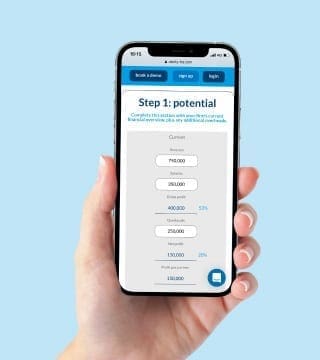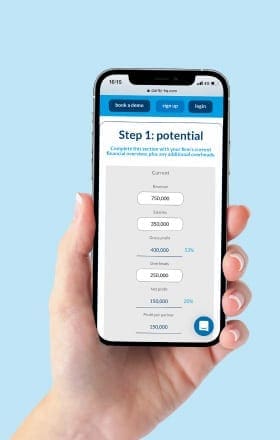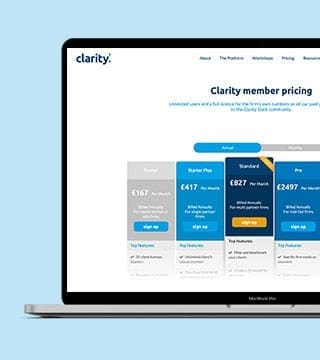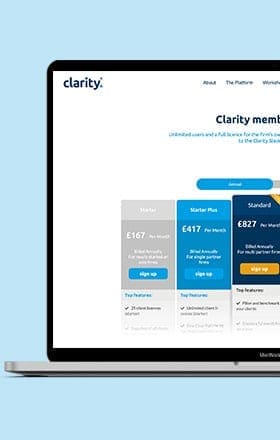Behind The 7 Key Numbers
Small business owners don’t get their numbers and don’t really understand their financial statements or reports. The Clarity platform condenses the many complicated numbers behind a business into 7 simple, key numbers. Our aim is to make business simple for small business owners and help YOU help your clients understand their numbers, and how to make them better. Effectively giving you the power to tell better stories with numbers.
COO at Clarity, Steven Briginshaw, digs a little deeper into what the 7 Key Numbers are, and why we have chosen them. Let’s dive in:
The 7 Key Numbers
1. Revenue Growth
The first number is revenue growth. Now, this is as it sounds, we’re looking at the revenue this year compared to the previous year to look for the growth that we want. And most businesses do want to grow, so we’re tracking here to make sure that the business is going in the right direction. Revenue is a really good indicator of a growing business. It’s not the be all and end all as you’ll find out, but it’s a good indicator.
2. Gross Profit Percentage
The next number is gross profit percentage. What we’re looking at here is making sure that the business is returning a good amount of profit from its main activities. Those costs that it incurs to make sales and also deliver the services or goods that they provide.
3. EBITDA percentage
The third number is EBITDA percentage. So, the EBITDA stands for earnings before interest, tax, depreciation, and amortization. We strip out those costs and then look at the earnings, or the adjusted profit in line with revenue, and again make sure that the percentage is in line with where the business needs it to be. This is looking more at overhead costs rather than cost of sales, which is covered in gross profit percentage.
4. Revenue per employee
Now, revenue per employee is a great number, because it doesn’t just look at the one fraction of the business, it looks at lots of different things. So, it’s looking at revenue obviously, it’s looking at employee costs. Then it’s also looking at employee capacity and productivity, and are they using the systems correctly? Do they have enough training? Are they using the right tools? It’s one number that looks at many different areas of the business, and it’s not just in isolation. So, it’s a really joined up approach to running the business from that one number, and it looks at culture as well across the whole board.
5. Core cash target
The fifth number is core cash target. This looks at the amount of cash that ideally the business will keep on hand before starting new projects or paying shareholders more dividends etc. It looks at the total taxes due and adds an element of overheads as a buffer. So it’s an amount, or core cash target that the business should have in reserve ideally. And any cash over and above that is surplus and can be used in the future for new projects, for additional payments to the business owners, or for recruiting new team members.
6. Cash days
Cash days is the sixth number, this is also known as working capital days. We’re looking at four different numbers here;
- Accounts receivable days – how long it takes for your customers to pay.
- Accounts payable days – how long it takes for you to pay your suppliers.
- Inventory days – how long it takes for your inventory, your stock to be turned into cash.
- Work in progress days – how quickly your work in progress is turned into cash.
So, it’s those four numbers put into one, called cash days. And that gives you a snapshot of how long it takes for the money to go through your business. And again, it’s an indicator of those four different areas. So, it’s a bit like revenue per employee, it looks like at a multitude of different areas within your business to make sure that you’re doing the right things in different areas, and you can tweak at least four different areas there to make those numbers improve for your business.
7. Business return
And the final number is business return. What we’re doing here is looking at what your business is worth to you based on its current profit basically. And I suppose another way of looking at it is, is the business producing a good enough return, or should you just stick your money that you invested into your business into the bank? That’s another way of looking at it to make sure that your hard work and effort into your business, and running your business, is actually producing the type of return that you want it to produce.
From our experience, these seven key numbers are essential for any business.
They’re generic enough to go across all businesses, but specific enough when you start to drill into the numbers, you can see how they can help individual businesses. Now, we’ve covered the profit and loss report, we’ve covered the balance sheet, we’ve covered the cashflow statement, and we’ve also looked at productivity.
These 7 key numbers cover all of the financial aspects of business and give you key insights into how to run, how your business is running, and also how to improve your business. And if you use that in conjunction with the future element of numbers within Clarity, you can then start to put some plans together and target some goals to help you get to your ideal business.
Like what you see?
Find out more about why the 7 key numbers in this special 7 key numbers webinar: https://www.youtube.com/watch?v=4pvpkvBPC4c&t=23s
Seen everything you need to see? Why not join our Getting Clear Workshop series and start your journey with Clarity this month! https://pages.clarity-hq.com/workshop
About Clarity
Effortless Advisory | Powerful Results
If you think Clarity is just a piece of software, you’re missing the point. It’s a mindset shift, a different way of doing business.
If you think Clarity is just about business advisory, you’re also missing the point. It’s way more than business advisory, it totally changes your firm’s story and that of your clients.
Finally, a joined-up platform that truly enables you to scale business advisory services within your firm. It’s been built by accountants for accountants. Award-winning accountants that have small business within their DNA.
Revolutionary approach
Rather than take a traditional approach, we have completely revolutionised the business advisory process for small business owners. Our end-to-end business advisory platform and member success team give you:
- the structure and processes to deliver;
- build confidence and engage the team;
- save time; and
- do all of this is a way that ensures your small business clients finally ‘get it’.
Making it easier and more profitable for the firm, at a price your small business clients can afford!
For more information or to book a demo visit clarity-hq.com






